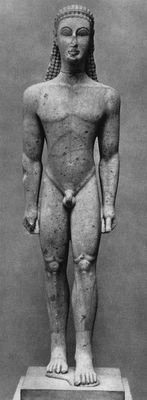Greek Sculpture as a Model for Understanding Evolutionary Process in Western Music
The polarities of "classical" and "romantic" are, of course, embodied by Apollo and Dionysus. The adherence to one tenet or the other is not wholly determined by the creator, but often by the state of technical evolution of the genre in which in he works. The reality is apparent in the evolution of Greek statuary, and the nature of the process holds true for other art media including music. The cycle depicted in Greek statuary is repeated in Western music, and will become a touchstone.
There are three stages of ancient Greek sculpture, archaic, classic, and Hellenistic. The emergence of a romantic spirit in art or music, as in the sculpture below, assumes that there is an inherited starting point with regard to form and that the realization of the romantic spirit is ennabled by the technical progress in the medium. Finally, the classical or romantic spirit does not necessarily have to dominate a work; both can be present in varying degrees.
The earliest stage of Greek sculpture clearly draws upon the achievements of the Egyptians. The first sculpture, "Mycerinus and His Queen," is an example of Egyptian sculpture which dates from c2500 B.C. It is clearly representative, though the actual features are clearly idealized rather than reflective of how the characters actually appeared in life.

Mycerinus and His Queen
The straight-on frontal view of the king and the placement of his feet, one before the other, is retained in the second sculpture, the Greek "Kouros (Standing youth)," a work dating from c600 B.C.

Kouros
In the case of the Kouros, however, the placement of the feet represents a significant forward stride in engineering. The placement permits the statue to stand unsupported. The idealized rendering of the parts of the body, a characteristic of Egyptian art, is also evident in the Kouros. Egyptian artists represented the part of the body from its most typical angle, that is, the chest is depicted from the front, the arms and legs from the side, and so forth. The custom is not apparent in the example of sculpture, but is easily found in paintings and bas reliefs.
"Doryphorus" (the "Spear-Bearer") is a Roman copy of an original by Policitus dating from c450 B.C. It brings Greek sculpture into its Classic era. The musculature is carefully represented but, despite the extensive detail, the proportions are not accurate to life. Instead, the sculpture was guided by the aesthetic ideals of form, balance, and clarity. The result owes its posture to the Kouri and Mycerinus in turn, but its aim is the achievement of a high level of ordered beauty. Note that the sculpture is not truly freestanding.

doryphorus

Discobolus
Vestiges of Kouros are apparent in both "Aphrodite of the Cnidians," the female figure on the left, and "Hermes," the male on the right. Both works are Roman copies after originals by Praxiteles c330-320 B.C. The further refinement of the musculature is one clue to the coming Hellenistic Age, but the real signal is found in the softening of the posture so that it borders on sensual. Moreover, Hermes posture also conveys feminine characteristics. That the figures permit a sensual component shows a subtle breakdown in the tenets of classicism that otherwise inform the works.
Praxiteles: Hermes and Aphrodite
Yet, the romantic qualities of the scene cannot completely hide the classical components that inform it. As noted, there is the symmetry. The bodies, though the details are exaggerated in their development, still represent "ideal" rather than "real" or "natural" renderings of human form. The punishment, as dramatic as it is, does not convey to the viewer the true horror of death by serpent, but instead broadcasts punishment in a frozen, antiseptic, and rhetorical sense.

Lacoon
The "Dying Gaul," which dates from c230-220 B.C., brings home forcefully the darker side of romanticism. The scale of human morphology is toned down so that it is closer to that of the normal male. The subject is not presented in a glossed, cleaned up form. The soldier is dying, and every aspect of the sculpture realistically conveys the fact from the bowed head to the slight crook in the supporting arm. The viewer is drawn into his plight and can only wait quietly with him until the end comes.

Dying Gaul
The progression occurs in three stages. First, a model is abosorbed and adapted for use, as often as not by a newly ascending or emerging culture. Second, the absorption of the model is complete in the "classic" stage, the point at which the tenets of the new style are defined and all the technical problems to realization are resolved. In the last stage, virtuostic displays often result. Here the realization of the work and the technical mastery required supplant the content of the work. The tenets as defined in the classic apogee give way to deformation of those very tenets. Three segments of the progression record the rise and degeneration of a means of expression or style of art. The third and final stage of development, of course, gives way to new ideas, and the cycle begins anew. In the course of the history of Western music, the birth to death cycle repeats at least three times, with smaller similar cycles contained within the larger ones.

<< Home